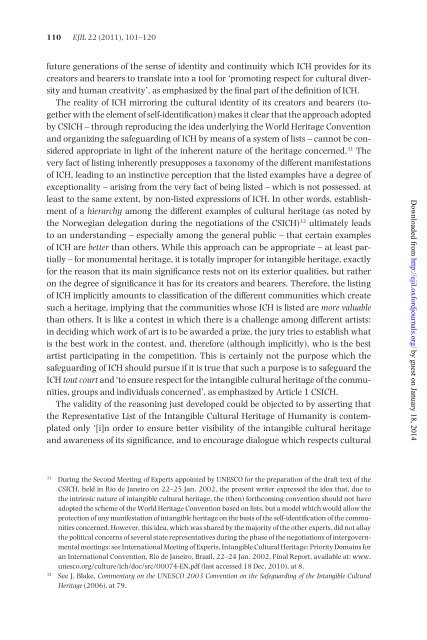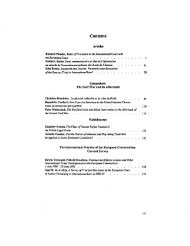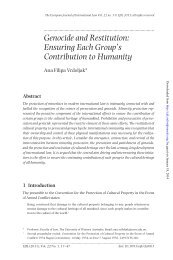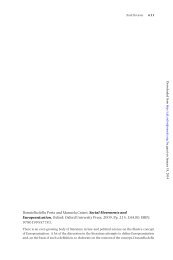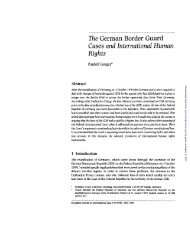Intangible Cultural Heritage - European Journal of International Law
Intangible Cultural Heritage - European Journal of International Law
Intangible Cultural Heritage - European Journal of International Law
Create successful ePaper yourself
Turn your PDF publications into a flip-book with our unique Google optimized e-Paper software.
110 EJIL 22 (2011), 101–120<br />
future generations <strong>of</strong> the sense <strong>of</strong> identity and continuity which ICH provides for its<br />
creators and bearers to translate into a tool for ‘promoting respect for cultural diversity<br />
and human creativity’, as emphasized by the final part <strong>of</strong> the definition <strong>of</strong> ICH.<br />
The reality <strong>of</strong> ICH mirroring the cultural identity <strong>of</strong> its creators and bearers (together<br />
with the element <strong>of</strong> self-identification) makes it clear that the approach adopted<br />
by CSICH – through reproducing the idea underlying the World <strong>Heritage</strong> Convention<br />
and organizing the safeguarding <strong>of</strong> ICH by means <strong>of</strong> a system <strong>of</strong> lists – cannot be considered<br />
appropriate in light <strong>of</strong> the inherent nature <strong>of</strong> the heritage concerned. 31 The<br />
very fact <strong>of</strong> listing inherently presupposes a taxonomy <strong>of</strong> the different manifestations<br />
<strong>of</strong> ICH, leading to an instinctive perception that the listed examples have a degree <strong>of</strong><br />
exceptionality – arising from the very fact <strong>of</strong> being listed – which is not possessed, at<br />
least to the same extent, by non-listed expressions <strong>of</strong> ICH. In other words, establishment<br />
<strong>of</strong> a hierarchy among the different examples <strong>of</strong> cultural heritage (as noted by<br />
the Norwegian delegation during the negotiations <strong>of</strong> the CSICH) 32 ultimately leads<br />
to an understanding – especially among the general public – that certain examples<br />
<strong>of</strong> ICH are better than others. While this approach can be appropriate – at least partially<br />
– for monumental heritage, it is totally improper for intangible heritage, exactly<br />
for the reason that its main significance rests not on its exterior qualities, but rather<br />
on the degree <strong>of</strong> significance it has for its creators and bearers. Therefore, the listing<br />
<strong>of</strong> ICH implicitly amounts to classification <strong>of</strong> the different communities which create<br />
such a heritage, implying that the communities whose ICH is listed are more valuable<br />
than others. It is like a contest in which there is a challenge among different artists:<br />
in deciding which work <strong>of</strong> art is to be awarded a prize, the jury tries to establish what<br />
is the best work in the contest, and, therefore (although implicitly), who is the best<br />
artist participating in the competition. This is certainly not the purpose which the<br />
safeguarding <strong>of</strong> ICH should pursue if it is true that such a purpose is to safeguard the<br />
ICH tout court and ‘to ensure respect for the intangible cultural heritage <strong>of</strong> the communities,<br />
groups and individuals concerned’, as emphasized by Article 1 CSICH.<br />
The validity <strong>of</strong> the reasoning just developed could be objected to by asserting that<br />
the Representative List <strong>of</strong> the <strong>Intangible</strong> <strong>Cultural</strong> <strong>Heritage</strong> <strong>of</strong> Humanity is contemplated<br />
only ‘[i]n order to ensure better visibility <strong>of</strong> the intangible cultural heritage<br />
and awareness <strong>of</strong> its significance, and to encourage dialogue which respects cultural<br />
Downloaded from http://ejil.oxfordjournals.org/ by guest on January 18, 2014<br />
31<br />
During the Second Meeting <strong>of</strong> Experts appointed by UNESCO for the preparation <strong>of</strong> the draft text <strong>of</strong> the<br />
CSICH, held in Rio de Janeiro on 22–25 Jan. 2002, the present writer expressed the idea that, due to<br />
the intrinsic nature <strong>of</strong> intangible cultural heritage, the (then) forthcoming convention should not have<br />
adopted the scheme <strong>of</strong> the World <strong>Heritage</strong> Convention based on lists, but a model which would allow the<br />
protection <strong>of</strong> any manifestation <strong>of</strong> intangible heritage on the basis <strong>of</strong> the self-identification <strong>of</strong> the communities<br />
concerned. However, this idea, which was shared by the majority <strong>of</strong> the other experts, did not allay<br />
the political concerns <strong>of</strong> several state representatives during the phase <strong>of</strong> the negotiations <strong>of</strong> intergovernmental<br />
meetings: see <strong>International</strong> Meeting <strong>of</strong> Experts, <strong>Intangible</strong> <strong>Cultural</strong> <strong>Heritage</strong>: Priority Domains for<br />
an <strong>International</strong> Convention, Rio de Janeiro, Brazil, 22–24 Jan. 2002, Final Report, available at: www.<br />
unesco.org/culture/ich/doc/src/00074-EN.pdf (last accessed 18 Dec. 2010), at 8.<br />
32<br />
See J. Blake, Commentary on the UNESCO 2003 Convention on the Safeguarding <strong>of</strong> the <strong>Intangible</strong> <strong>Cultural</strong><br />
<strong>Heritage</strong> (2006), at 79.


